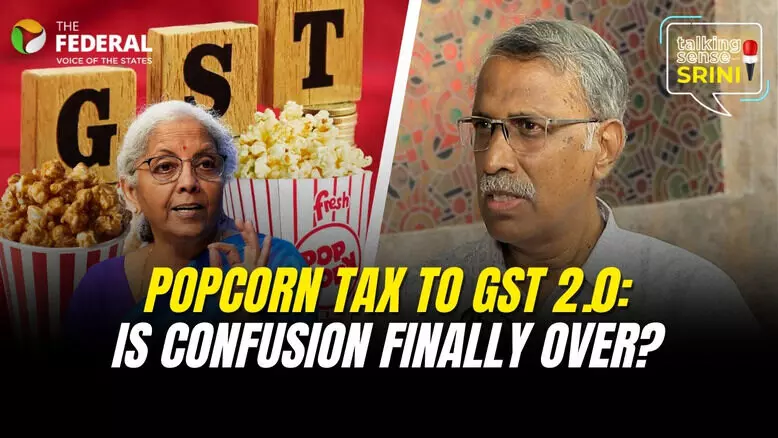
Speaking on 'Talking Sense With Srini', S Srinivasan, Editor-in-Chief of The Federal, noted that the government’s motivations are layered.
GST 2.0: Will 2 slabs simplify India's tax maze? | Talking Sense with Srini
The government recently unveiled GST 2.0, slashing rates on hundreds of goods and collapsing multiple slabs into a simplified framework

India's indirect tax system has undergone yet another reset. The government recently unveiled GST 2.0, slashing rates on hundreds of goods and collapsing multiple slabs into a simplified framework. While pitched as a reform to spur consumption, the move also arrives at a politically-sensitive moment - just as India grapples with sluggish growth and the aftershocks of Trump-era tariffs.
Speaking on Talking Sense With Srini, S Srinivasan, Editor-in-Chief of The Federal, noted that the government’s motivations are layered.
“It’s not just about spurring consumption. There’s also the pressure of fiscal federalism, long-standing demands from states and opposition parties, and a visible need to simplify India’s complex tax system.”
At first glance, GST 2.0 reduces the system to two key slabs – 5 per cent and 18 per cent, with higher rates for sin goods. But as Srinivasan pointed out, India still effectively operates five slabs, including exemptions and special rates like 3 per cent for gold. Compared to Europe, where VAT is closer to a single rate with minimal exemptions, India still has some distance to cover.
Also Read: 'GST 2.0 is a correction, not a reform; earlier model was exploitative'
Feel-good reform
However, packaged foods, FMCG items, personal care, and kitchenware are now cheaper. Insurance premiums and several farm-related goods also see relief, a move clearly aimed at the middle class and rural households ahead of the festive season.
“It’s a feel-good reform timed right before consumption peaks,” Srinivasan said.
‘Invisible hikes’
While rate cuts dominate headlines, experts warn of less visible hikes. Coal now attracts 18 per cent GST instead of 5 per cent, raising the prospect of higher electricity costs. Refined petroleum products sent via pipelines also face higher taxes.
“These invisible hikes could eventually pinch consumers, even if the immediate narrative is about lower prices,” Srinivasan cautioned, citing commentary by columnist TK Arun on The Federal.
Also Read: GST 2.0: Historic reform or delayed fix? Political, economic angles decoded
GST has always been a flashpoint in Centre–State relations. The government estimates a Rs 48,000 crore notional revenue loss from the cuts, though Srinivasan argues this is overstated.
“It’s just 0.13 per cent of GDP, and higher consumption could offset much of it,” he said.
With the Centre retaining veto power in the GST Council, he doesn’t expect major structural tensions with states to flare up solely over this reform.
Reviving sluggish demand
The big question: is GST 2.0 a structural reset or just another short-term stimulus? Srinivasan believes it’s both. Simplification is welcome and overdue, but the timing suggests the government is also scrambling to revive sluggish demand.
“Unless consumption rises, private investment won’t return. Companies are running at 70–75 per cent capacity and won’t expand otherwise,” he said.
Also Read: GST reform shows how indirect taxes can be made even more indirect
GST 2.0 signals intent to simplify taxation and provide a consumption-led boost. But the fine print matters: while households may enjoy cheaper goods this festive season, businesses and consumers alike must brace for invisible costs creeping in through energy and logistics.
As Srinivasan summed up, “Outwardly, it looks like a major change. But we’ll only know the true shape of the animal once the fine print settles.”
(The content above has been generated using a fine-tuned AI model. To ensure accuracy, quality, and editorial integrity, we employ a Human-In-The-Loop (HITL) process. While AI assists in creating the initial draft, our experienced editorial team carefully reviews, edits, and refines the content before publication. At The Federal, we combine the efficiency of AI with the expertise of human editors to deliver reliable and insightful journalism.)

